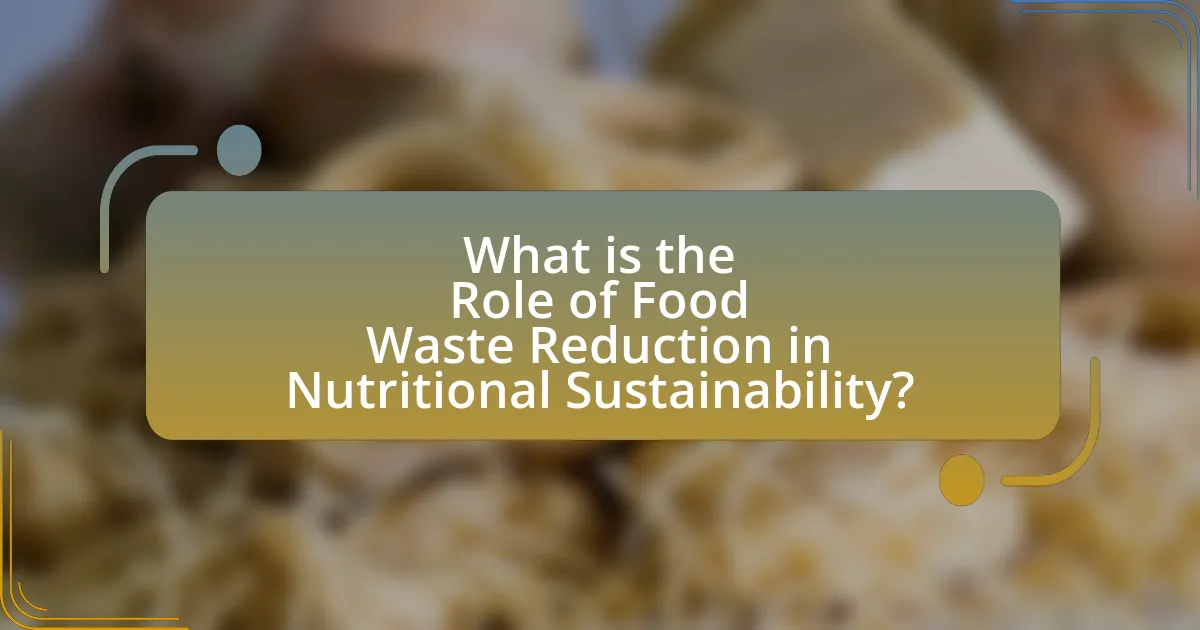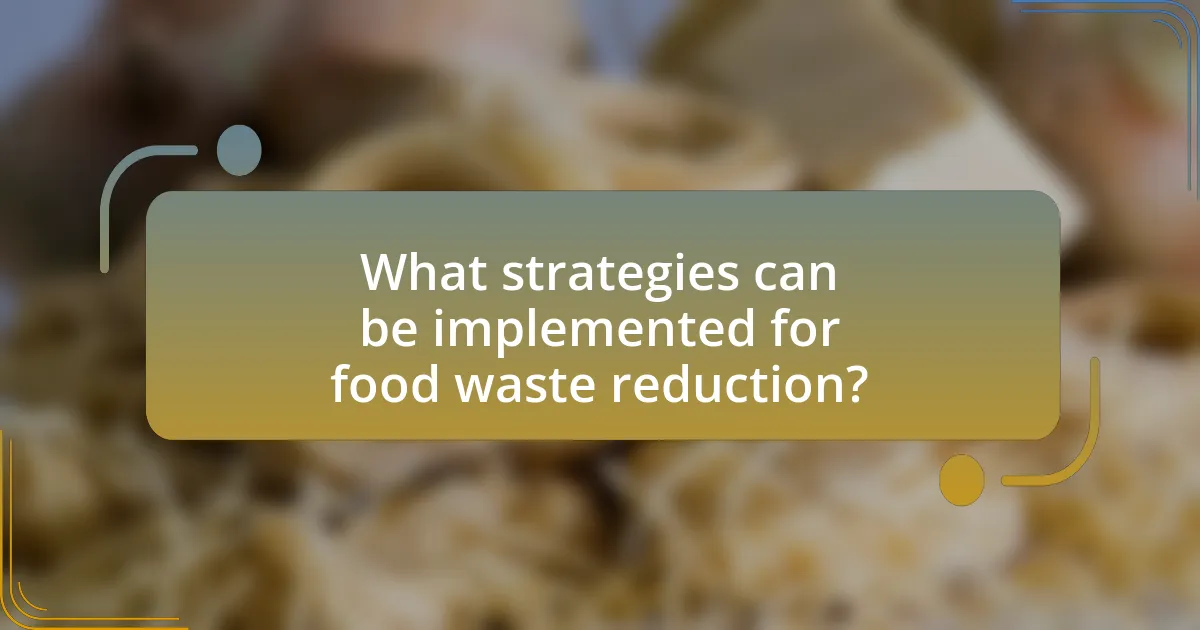Food waste reduction is a crucial factor in achieving nutritional sustainability, as it enhances food security and minimizes the environmental impact of food production. Approximately one-third of all food produced globally is wasted, leading to significant losses in nutrients and resources, while also contributing to greenhouse gas emissions. The article explores the impact of food waste on nutritional sustainability, the statistics surrounding food waste, and its role in food insecurity. It also discusses strategies for reducing food waste at individual and systemic levels, highlighting the importance of consumer behavior, business practices, and policy initiatives in addressing this pressing issue.

What is the Role of Food Waste Reduction in Nutritional Sustainability?
Food waste reduction plays a critical role in nutritional sustainability by ensuring that more food is available for consumption, thereby enhancing food security and reducing the environmental impact of food production. When food is wasted, not only are the resources used in its production lost, but it also contributes to greenhouse gas emissions, which exacerbate climate change. According to the Food and Agriculture Organization (FAO), approximately one-third of all food produced globally is wasted, which translates to about 1.3 billion tons annually. This waste represents a significant loss of nutrients that could otherwise support healthy diets. By minimizing food waste, we can improve the efficiency of food systems, promote better resource management, and ultimately contribute to healthier populations and ecosystems.
How does food waste impact nutritional sustainability?
Food waste significantly undermines nutritional sustainability by depleting resources that could otherwise contribute to food security and health. When food is wasted, the nutrients it contains are lost, which exacerbates issues of malnutrition and food scarcity. According to the Food and Agriculture Organization, approximately one-third of all food produced globally is wasted, equating to about 1.3 billion tons annually. This waste not only represents a loss of nutritional value but also wastes the water, energy, and labor invested in food production. Furthermore, food waste contributes to environmental degradation, as decomposing food in landfills generates greenhouse gases, further impacting climate change and agricultural productivity. Thus, reducing food waste is essential for enhancing nutritional sustainability and ensuring that available food resources are utilized effectively to meet the nutritional needs of the population.
What are the key statistics related to food waste and nutrition?
Approximately one-third of all food produced globally is wasted, equating to about 1.3 billion tons annually. This waste not only represents a significant loss of resources but also contributes to 8-10% of global greenhouse gas emissions. In terms of nutrition, food waste disproportionately affects low-income populations, as it is estimated that reducing food waste could provide enough food to feed 1.26 billion people who are undernourished. Furthermore, fruits and vegetables account for the highest percentage of food waste, with about 45% of these items discarded, which directly impacts dietary diversity and nutrition quality.
How does food waste contribute to food insecurity?
Food waste significantly contributes to food insecurity by diverting resources away from those in need. When food is wasted, the energy, labor, and materials used in its production are also wasted, which exacerbates the scarcity of food available for consumption. According to the Food and Agriculture Organization (FAO), approximately one-third of all food produced globally is wasted, amounting to about 1.3 billion tons per year. This waste not only represents a loss of potential nourishment for vulnerable populations but also increases the demand for food production, putting further strain on agricultural systems. Consequently, reducing food waste can enhance food availability and accessibility, thereby alleviating food insecurity.
Why is food waste reduction important for sustainable nutrition?
Food waste reduction is crucial for sustainable nutrition because it directly impacts resource conservation and food security. When food is wasted, the resources used in its production, such as water, energy, and labor, are also wasted, contributing to environmental degradation. According to the Food and Agriculture Organization (FAO), approximately one-third of all food produced globally is wasted, which equates to about 1.3 billion tons annually. This waste not only exacerbates hunger but also leads to increased greenhouse gas emissions, as decomposing food in landfills releases methane, a potent climate change contributor. Therefore, reducing food waste is essential for promoting efficient resource use and ensuring that more food is available to meet the nutritional needs of the growing global population.
What are the environmental benefits of reducing food waste?
Reducing food waste significantly benefits the environment by decreasing greenhouse gas emissions, conserving water, and preserving biodiversity. When food is wasted, it contributes to about 8-10% of global greenhouse gas emissions, primarily from decomposing organic matter in landfills. Additionally, food production is resource-intensive; for instance, producing one kilogram of beef requires approximately 15,000 liters of water. By minimizing food waste, we can conserve these vital resources and reduce the strain on ecosystems. Furthermore, less food waste means less pressure on agricultural land, which helps protect habitats and biodiversity.
How does reducing food waste improve public health?
Reducing food waste improves public health by increasing the availability of nutritious food and decreasing environmental impacts that contribute to health issues. When food is wasted, the resources used for its production, such as water, land, and energy, are also wasted, leading to unsustainable practices that can harm ecosystems and public health. According to the Food and Agriculture Organization, approximately one-third of all food produced globally is wasted, which could otherwise feed billions of people and alleviate hunger. Furthermore, reducing food waste can lower greenhouse gas emissions, which are linked to respiratory diseases and other health problems. By minimizing waste, communities can enhance food security, promote healthier diets, and reduce the burden of diet-related diseases.

What strategies can be implemented for food waste reduction?
Strategies for food waste reduction include implementing better inventory management, enhancing food donation programs, and promoting consumer education on food preservation. Effective inventory management, such as using the First In, First Out (FIFO) method, helps retailers minimize spoilage and overstock. Food donation programs, supported by organizations like Feeding America, facilitate the redistribution of surplus food to those in need, reducing waste while addressing hunger. Consumer education initiatives, such as campaigns by the USDA, inform individuals about proper food storage techniques and meal planning, which can significantly decrease household food waste. These strategies collectively contribute to nutritional sustainability by ensuring that food resources are utilized efficiently and responsibly.
How can individuals contribute to food waste reduction?
Individuals can contribute to food waste reduction by planning meals, properly storing food, and utilizing leftovers. Meal planning helps in purchasing only necessary items, reducing impulse buys that often lead to waste. Proper food storage techniques, such as using airtight containers and understanding expiration dates, can extend the life of perishable items. Additionally, creatively using leftovers in new dishes minimizes waste and maximizes food utility. According to the Food and Agriculture Organization, approximately one-third of all food produced globally is wasted, highlighting the significant impact individual actions can have on reducing this statistic.
What are effective meal planning techniques to minimize waste?
Effective meal planning techniques to minimize waste include creating a detailed shopping list based on planned meals, utilizing leftovers creatively, and practicing portion control. A detailed shopping list prevents impulse purchases and ensures that only necessary ingredients are bought, reducing the likelihood of food spoilage. Utilizing leftovers creatively, such as incorporating them into new dishes, helps to ensure that food is consumed rather than discarded. Practicing portion control by measuring servings can prevent over-preparation and excess food waste. According to the Food and Agriculture Organization, approximately one-third of food produced globally is wasted, highlighting the importance of these techniques in promoting sustainability.
How can proper food storage reduce waste?
Proper food storage can significantly reduce waste by extending the shelf life of perishable items and preventing spoilage. When food is stored correctly, such as in appropriate temperatures and conditions, it maintains its freshness and nutritional value for a longer period. For instance, storing fruits and vegetables in the right humidity levels can prevent them from wilting or rotting prematurely. According to the USDA, proper refrigeration can slow down the growth of bacteria, which is a leading cause of food spoilage. This practice not only minimizes the amount of food that is discarded but also contributes to more efficient use of resources, aligning with the goals of nutritional sustainability.
What role do businesses play in reducing food waste?
Businesses play a crucial role in reducing food waste by implementing sustainable practices throughout their supply chains. These practices include optimizing inventory management, improving food storage techniques, and donating surplus food to charities. For instance, a study by the Food Waste Reduction Alliance found that businesses that adopt waste tracking systems can reduce food waste by up to 50%. Additionally, companies like Walmart have committed to reducing food waste in their operations by 50% by 2025, showcasing the impact of corporate responsibility on food waste reduction.
What practices can restaurants adopt to minimize food waste?
Restaurants can minimize food waste by implementing practices such as portion control, inventory management, and food donation programs. Portion control helps reduce excess food served to customers, thereby decreasing leftovers. Effective inventory management ensures that ingredients are used before their expiration dates, reducing spoilage. Additionally, establishing partnerships with local food banks allows restaurants to donate surplus food, which can significantly lower waste levels. According to the Food Waste Reduction Toolkit by the USDA, restaurants can reduce food waste by up to 30% through these strategies, contributing to both economic savings and nutritional sustainability.
How can grocery stores manage inventory to reduce waste?
Grocery stores can manage inventory to reduce waste by implementing advanced inventory management systems that utilize real-time data analytics. These systems enable stores to track product sales, monitor expiration dates, and adjust orders based on demand forecasts, which minimizes overstocking and spoilage. For instance, a study by the Food Waste Reduction Alliance found that retailers using data-driven inventory practices can reduce food waste by up to 30%. Additionally, grocery stores can adopt strategies such as dynamic pricing for near-expiration items and donating unsold food to local charities, further decreasing waste while supporting community needs.

What are the challenges in achieving food waste reduction?
Achieving food waste reduction faces several challenges, including consumer behavior, supply chain inefficiencies, and lack of awareness. Consumer behavior often leads to over-purchasing and improper storage, resulting in food spoilage; studies indicate that households are responsible for approximately 61% of food waste in developed countries. Supply chain inefficiencies, such as inadequate logistics and processing capabilities, contribute to significant losses before food even reaches consumers. Additionally, a lack of awareness about the environmental and economic impacts of food waste hinders efforts to implement effective reduction strategies. According to the Food and Agriculture Organization, approximately one-third of all food produced globally is wasted, highlighting the urgency of addressing these challenges.
What barriers do consumers face in reducing food waste?
Consumers face several barriers in reducing food waste, including lack of awareness, convenience, and economic factors. Many individuals are unaware of the extent of food waste and its environmental impact, which diminishes their motivation to change behaviors. Convenience plays a significant role, as busy lifestyles often lead to purchasing more food than needed, resulting in spoilage. Economic factors also contribute, as consumers may prioritize low prices over quality, leading to the purchase of items that spoil quickly. According to a study by the Food and Agriculture Organization, approximately one-third of food produced globally is wasted, highlighting the need for consumer awareness and behavioral change to address this issue effectively.
How does consumer behavior influence food waste levels?
Consumer behavior significantly influences food waste levels through purchasing habits, consumption patterns, and attitudes towards food. For instance, consumers often buy more food than needed due to promotions or bulk buying, leading to excess that may spoil before consumption. Research indicates that approximately 30-40% of the food supply in the United States is wasted, with consumer behavior being a primary contributor (USDA, 2021). Additionally, consumers’ lack of awareness about food storage and preparation can result in unnecessary waste, as many do not utilize leftovers or misinterpret expiration dates. This behavior underscores the need for targeted education and awareness campaigns to mitigate food waste effectively.
What misconceptions exist about food expiration dates?
Many misconceptions exist about food expiration dates, primarily that they indicate safety rather than quality. Consumers often believe that food is unsafe to eat after the expiration date, but most dates, such as “best by” or “sell by,” are about quality rather than safety. Research from the USDA indicates that food can still be safe to consume after these dates if stored properly. Additionally, the confusion surrounding these labels contributes significantly to food waste, as approximately 30-40% of the food supply in the U.S. is wasted, much of which is still edible.
What systemic issues contribute to food waste in the supply chain?
Systemic issues that contribute to food waste in the supply chain include inefficiencies in logistics, lack of coordination among stakeholders, and inadequate storage facilities. Inefficiencies in logistics, such as poor transportation routes and delays, lead to spoilage before products reach consumers. Lack of coordination among producers, distributors, and retailers results in mismatched supply and demand, causing excess inventory that often goes unsold. Inadequate storage facilities, particularly in developing regions, exacerbate these problems by failing to maintain optimal conditions for perishable goods, leading to significant losses. According to the Food and Agriculture Organization, approximately one-third of food produced globally is wasted, highlighting the critical impact of these systemic issues on food sustainability.
How do agricultural practices affect food waste rates?
Agricultural practices significantly influence food waste rates by determining the efficiency of production, harvesting, and post-harvest handling. For instance, practices such as crop rotation and integrated pest management can enhance yield quality and reduce losses during harvest, thereby minimizing waste. According to the Food and Agriculture Organization (FAO), approximately 1.3 billion tons of food are wasted annually, with a substantial portion occurring at the agricultural stage due to inadequate practices. Furthermore, the use of technology in precision agriculture can optimize resource use and reduce overproduction, which directly correlates with lower food waste rates.
What role does policy play in food waste management?
Policy plays a crucial role in food waste management by establishing regulations and frameworks that guide waste reduction practices. Effective policies can incentivize businesses and consumers to minimize food waste through measures such as tax breaks for donations, mandates for composting, and public awareness campaigns. For instance, the European Union’s Circular Economy Action Plan aims to reduce food waste by 50% by 2030, demonstrating the impact of legislative initiatives on waste reduction efforts. Such policies not only promote sustainable practices but also contribute to nutritional sustainability by ensuring that more food reaches those in need rather than ending up in landfills.
What are practical tips for reducing food waste at home?
To reduce food waste at home, implement strategies such as meal planning, proper food storage, and utilizing leftovers. Meal planning helps in purchasing only necessary ingredients, thereby minimizing excess. Proper food storage, including using airtight containers and understanding expiration dates, extends the life of perishable items. Utilizing leftovers creatively, such as incorporating them into new meals, further decreases waste. According to the Food and Agriculture Organization, approximately one-third of food produced globally is wasted, highlighting the importance of these practices in promoting sustainability.
How can one effectively use leftovers to minimize waste?
One can effectively use leftovers to minimize waste by repurposing them into new meals or ingredients. For instance, leftover vegetables can be transformed into soups, stir-fries, or casseroles, while stale bread can be made into croutons or breadcrumbs. According to the USDA, approximately 30-40% of the food supply in the United States is wasted, highlighting the importance of utilizing leftovers to combat this issue. By creatively incorporating leftovers into daily cooking, individuals can significantly reduce food waste and contribute to nutritional sustainability.
What are some creative ways to repurpose food scraps?
Creative ways to repurpose food scraps include using vegetable peels to make broth, composting fruit scraps for nutrient-rich soil, and transforming stale bread into croutons or breadcrumbs. These methods not only reduce waste but also contribute to sustainability by maximizing the use of food resources. For instance, vegetable scraps can yield a flavorful broth, which is a common practice in many culinary traditions, thereby minimizing food waste while enhancing meal preparation. Composting fruit scraps can divert waste from landfills, as composting reduces methane emissions and enriches soil health, supporting sustainable agriculture. Additionally, repurposing stale bread into croutons or breadcrumbs prevents food from being discarded and provides a cost-effective way to enhance dishes.


